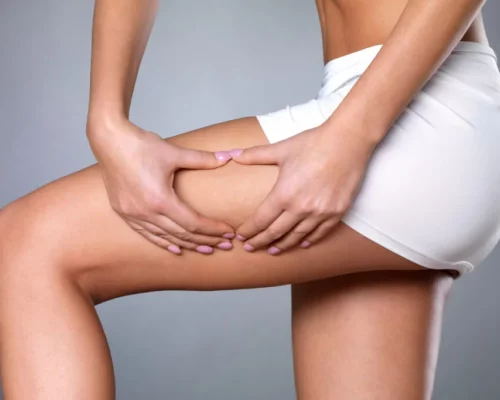Let’s talk about cellulite — that lumpy, bumpy skin we often see on our thighs, hips, butt, and stomach. You know it. Maybe you’ve scrutinized it in the mirror or poked at it wondering if you should try some new cream or treatment. You’ve probably also heard a lot of different explanations: it’s fat, it’s genetics, it’s your diet, it’s hormones.
Here’s the real talk: while all those things can play a role, cellulite is, at its core, a lymphatic issue. And understanding that makes it a lot easier (and less stressful) to deal with.
First Things First: What Is Cellulite, Really?
Cellulite is the dimpled appearance that happens when fat deposits push through connective tissue beneath the skin. It’s completely normal, and nearly 90% of women will have it at some point, no matter their weight or fitness level. Men can get it too, though it’s less common because of the way their connective tissue is structured.
It’s not a “flaw.” It’s just biology. But why does it happen more in some people than others? And why does it get worse over time?
This is where the lymphatic system comes in … Savvy Wellness in Lone Tree specializes in lymphatic drainage and are lymphatic and detox experts.
Meet Your Lymphatic System
Your lymphatic system is like your body’s unsung hero. It’s a huge network of vessels and nodes running just under your skin. Its job? Clearing waste, toxins, excess fluids, and other junk from your tissues and sending them off to be eliminated. Think of it as your body’s natural drainage system.
Unlike your blood, which has the heart to pump it around, your lymph fluid doesn’t have a central pump. It relies on movement — walking, stretching, deep breathing — to keep things flowing. When your lymphatic system gets sluggish, waste starts to build up between cells. Fluid gets trapped. Inflammation sets in.
And guess what? That trapped fluid, waste, and inflammation can make the fat beneath your skin swell and stiffen. The result: more visible cellulite.
How a Sluggish Lymphatic System Leads to Cellulite
When your lymphatic flow is slow, it’s like a traffic jam under your skin. Normally, fat cells are small and evenly distributed. But with poor drainage, waste builds up around them. This buildup causes fat cells to swell and push up against the skin while the connective tissue bands pull down, creating that classic “cottage cheese” or “orange peel” look.
Other factors like hormones (especially estrogen), poor diet, dehydration, sitting too much, and stress can all worsen lymphatic congestion. So can wearing tight clothes for long periods — anything that compresses lymph vessels can slow down flow.
In other words, cellulite isn’t just about fat. It’s about fluid, waste, and inflammation stuck where it shouldn’t be.
Why This Perspective Is Empowering
Understanding cellulite as a lymphatic issue is good news, because it means it’s not just about “losing weight” or “getting toned.” It’s about helping your body work the way it’s supposed to. And there are simple, doable things you can do to support your lymphatic health — and in turn, reduce the appearance of cellulite.
No, it’s not an overnight fix. But steady, loving attention to your body can make a big difference.
How to Boost Your Lymphatic Flow (and Help Cellulite)
Here are some down-to-earth ways to help your lymphatic system — and your skin — look and feel better:
1. Move Your Body
Movement is essential. Even light activities like walking, rebounding (mini trampoline bouncing), yoga, or stretching encourage lymph to flow. You don’t need to exhaust yourself — gentle, regular movement is key.
2. Dry Brushing
This old-school technique really works. Using a dry, natural bristle brush, you gently brush your skin in sweeping motions toward your heart. It stimulates lymph flow and exfoliates your skin at the same time. Just a few minutes before your shower can make a difference.
3. Stay Hydrated
Your lymph fluid is mostly water. When you’re dehydrated, everything gets sluggish. Drink plenty of clean water daily. Adding a squeeze of lemon can help too.
4. Lymphatic Drainage and Detox
Manual lymphatic drainage is a special type of massage designed to encourage the movement of lymph. Even a simple, gentle self-massage at home, always stroking toward the heart, can help.
5. Breathe Deeply
Deep belly breathing isn’t just relaxing — it actually helps pump lymph through your system. Take a few moments during the day to pause and breathe deeply in and out through your nose.
6. Eat Clean, Anti-Inflammatory Foods
What you eat affects your lymphatic system. Focus on whole foods — lots of fruits, veggies, clean proteins, healthy fats. Avoid processed foods that create more waste and inflammation in the body.
7. Relax and De-Stress
Chronic stress floods your body with hormones that can cause inflammation and fluid retention. Prioritize rest, fun, and joy where you can.
The Bottom Line
Cellulite isn’t a personal failure. It’s not something shameful or wrong. It’s a totally normal response to how your body manages waste, fluid, and fat — and how well your lymphatic system is working.
When you start looking at cellulite through the lens of lymphatic health, it becomes less about “fixing” yourself and more about supporting yourself. Small, consistent changes in how you move, eat, and care for your body can go a long way.
So instead of waging war on your thighs or stressing over new bumps, consider it a loving nudge from your body: “Hey, let’s get things flowing again.” It’s not about perfection — it’s about connection.
Call Savvy Wellness in Lone Tree today to find out about your options to help support the lymphatic system and lymphatic fluids to prevent cellulite from happening in the first place! Savvy has services to bring lymphatic solutions.

